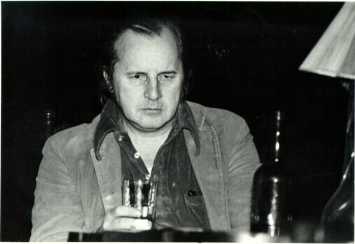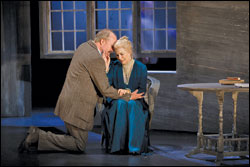In O'Neill's play, each of the four family members has his/her own contribution to the tensions and general dysfunction of the family. Choose one character and discuss her/his contribution to this dysfunction, commenting briefly on sections of the play in which she/he interacts with each of the other three.
Eugene O'Neill's play Long Day's Journey Night is a semi-autobiographical work which features a dysfunctional family. Each character finds a different way to contribute to the issues of the family and not one family member is able to get along with another family member. This could be because of drugs, alcohol, and disease, but their personalities seem to drive the dysfunction forward.
 |
| Broadway's version of O'Neill's play starring Jodie Lynne McClintock.* |
James Tyrone is the patriarch of the family and wants to be treated as such. He is an actor who has been stuck in the lead role of The Count of Monte Cristo. He used to be very talented, but remaining in the same role and repeating each performance has left him without much talent. James has missed out on the challenges of acting and settled for routine. As Jamie points out in Act 2, scene 1, James likes to hear himself talk and put on a show for everyone who comes along. However, in Act 3, scene 1, the audience hears that James is not a very good actor. He cannot convince anyone that he received good news from Doctor Hardy on the phone.
 |
A playbill for Eugene O’Neill’s father, one of the similarities James O’Neill shares with James Tyrone.* |
James Tyrone contributes to the family dysfunctions in a variety of ways. First, he is very frugal with his money, which comes from living in poverty as a child. He makes bargains with everyone for second-hand or second-rate things. Mary Tyrone points out that he bought her a used car, he paid for second-rate hotels, and he would not pay for good doctors. He pays for Mary to go to a sanatorium, just as he will with Edmund, but they are cheap places, and because of this, the medical attention they receive is poor. In addition to this, he likes to get drunk. Mary indicates that he was even drunk on their honeymoon and that every night on the road he would get drunk. She also reminds everyone that he is no stranger to barrooms. Third, he spends money on land that has little to no value. He lets people know that he is land-poor, meaning all of his money is tied up in land that is not getting any profit. James could be spending this money on better doctors for his wife, perhaps one that will end her habit, and for Edmund, so that he will be better in six to twelve months.
 |
Concord Player’s 1972 version of Long Day’s Journey into Night starring Bill McDonald as James Tyrone.* |
James and Mary are an interesting match. He was the actor, at the time meaning he had the bad-boy reputation, and she was wannabe nun, the good girl. However, the tables have turned and she is no longer the good girl. James tries to help her quit her addiction to morphine by himself, with doctors, and even at a sanatorium, but to no avail. When the play begins, he believes that she is finally cured, but is still suspicious of her every move because it is almost to good to be true. And it is. When James discovers his wife is using again, he realizes that he has been a fool and knows that nothing he can do will ever help her. She blames him for her addiction (keeping in mind, she blames everyone but herself for her addiction) because he did not pay for the best doctors and got drunk. When she is high, she regrets marrying him because of the past and her dreams of being a nun or concert pianist. The only way he knows how to deal with her addiction and accusations is to get drunk and forget about his problems, perhaps even his guilt.
 |
Mr. and Mrs. Tyrone in Sydney Theater’s Company’s version in 2010, played by William Hurt and Robyn Nevin.* |
James and Jamie often butt heads with each other and find ways to antagonize each other. Mary believes that Jamie has no respect for his father in Act 2, scene 1, but she is also under the influence. James looks down and Jamie because he does not have a job,a wife, or ambition, dropped out of several colleges, and still lives at home. Jamie despises his father's frugality and believes it to be a sign that he does not care about his family. Both men like to drink, but James does not like to share his alcohol keeping it locked up. He also knows that Jamie drinks it and pours water into it but does not say anything. Both men like to put on a show-- Jamie tells the audience of James doing it, but Jamie's way is different; he only lets people see certain sides of him (Edmund and Mary tell the audience this when describing him hiding from people while doing yard work). James knows Jamie's true intentions with and for Edmund, but is unable to convince the latter of this. The two men seem to be more alike than either one wants to admit.
 |
James (Paul Vincent O’Connor) and Jamie (Mark Anderson Phillips) in San Jose Repertory Theatre’s 2006-2007 version.* |
James' relationship with Jamie's brother, Edmund, is much different. He dislikes Edmund's anarchist thoughts and tries to get him on the right path for life. However, in doing so, James puts down Jamie, who Edmund, like any good younger sibling, looks up to. James also dislikes Edmund's poetry and sense of literature, because it is dark, not Catholic, and not Shakespeare. Edmund has inherited his father's love of liquor, and despite doctor's orders and health concerns, continues to drink. He drinks, just like his father, to forget his problems and his mother's morphine addiction. After Edmund is officially diagnosed, his father continues to fight with him but then feels guilty because of Edmund's condition. Just like modern times, people treat the diseased as though they are dying or could die at any minute, and that is how James treats Edmund. During the night, they have a heart-to-heart and Edmund feels that he understands his father better and convinces him to spend some money on a good hospital, all while under the three lights of the chandelier that James does not typically use in order to save on electricity.
 |
James (Jared McDavis) and Edmund (Wes Whitaker) in Western Illinois University’s 2009 version of the play.* |
* denotes pictures were obtained from Google Image search.
No comments:
Post a Comment